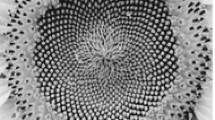Abstract
The new “clockspring” mathematics of Chris Illert is shown to apply to plant geometries and, in particular, to the dynamics processes of sprouting and flowering. Indeed, Kawaguchi's already successful model of branching corals and trees is found to be a simple first order version of Illert's generalised second order “clockspring” mathematics. The paper does not address the difficult variational mathematics of Illert's optimization problem but, instead, by concentrating upon the descriptive aspect, it has been possible to provide an alternative first-principles derivation of Illert's integral equation using simpler discrete analysis of a kind which will make this area of modelling more accessible to the very applied scientists who will benefit most from its existence and use. These new examples of Illert's mathematics further demonstrate its breadth of application in Theoretical Morphology. And its success in so many areas — Conchology, Embryology and Botany — should be contrasted with the dwindling returns of conventional models based upon traditional elasticity theory and continuum mechanics.
Riassunto
L'articolo dimostra come la nuova matematica di Chris Illert “a molla d'orologio” possa essere applicata alla geometria delle piante e, in particolare ai processi dinamici del germogliare e sbocciare di piante e fiori. Il fortunato modello di Kawaguchi sulla crescita dei rami dei coralli e degli alberi è senz'altro una versione di primo grado della versione di secondo grado di Illert sulla matematica “a molla d'orologio”. L'articolo non analizza la difficile matematica variazionale del problema dell'ottimizzazoine: concentrandosi sull'aspetto descrittivo, è stato infatti possibile fornire un primo principio di derivazione dell'equazione integrale di Illert, usando un tipo di analisi discreta più semplice; questa renderà quest'area di modelli più accessibile a chi lavora nel campo delle scienze applicate, che avrà così modo di utilizzare tali teorie e trarne i relativi vantaggi. Questi nuovi esempi della matematica di Illert dimostrano ulteriormente il suo vasto campo di applicazione nella morfologia teorica, ed il suo successo in tante aree — Conchiliologia, Embriologia, e Botanica — contrasta notevolmente con la scarsa utilità dei modelli convenzionali basati sulla teoria tradizionale dell'elasticità e la meccanica continua.
Similar content being viewed by others
References
L. Edwards,The field of form. Floris Books, Edinburgh 1982.
R. Erickson and W. Silk,The kinematics of plant growth. Scientific American242 (5), 110, May 1980.
C. Illert,The mathematics of gnomonic seashells. Math. Biosci.63 (1), 21–56 (1983).
C. Illert,General theory of life energy. J. Inferential & Deductive Biology1 (2), (March/April 1985).
C. Illert,Introduction to theoretical embryogenesis. In: Solved Problems in Bioelasticity, vol. 1, in press.
Y. Kawaguchi,A morphological study of the form of nature. Computer Graphics16 (3): 223–232 (1982). See also “Kawaguchi's spirals”. Omni 5 (2): 110–115 (Nov. 1982) and J. Deken's book “Computer images, state of the art”, Thames & Hudson 1983.
J. Keller,Tendril shape & lichen growth, Lect. on Maths. in the Life Sci.13, 257–270 (1980).
E. McCoy & L. Boersma,The principles of continuum mechanics applied to transport processes and deformation in plant tissue. J. theor. Biol.111, 687–705 (1984).
Author information
Authors and Affiliations
Rights and permissions
About this article
Cite this article
Reverberi, D. Clockspring model of sprouting and blossoming. Z. angew. Math. Phys. 36, 743–756 (1985). https://doi.org/10.1007/BF00960385
Received:
Issue Date:
DOI: https://doi.org/10.1007/BF00960385




